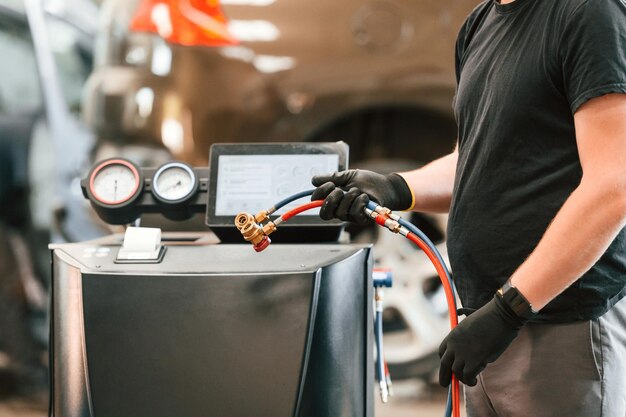If you’ve ever left a repair shop with a printed-out checklist or a color-coded sheet in your hand, chances are you were handed a vehicle inspection report. Maybe it was after an oil change, or perhaps your car was in for a strange noise, and your mechanic offered a “multi-point inspection.” But what do these reports actually mean? Are they just fluff, or are they telling you something important?
At Apex Auto Care in Waldorf, MD, we believe that car owners deserve clarity—not confusion—when it comes to vehicle inspections. That’s why we take the time to walk you through the results and answer every question you may have. So let’s break it all down together: What is a vehicle inspection report, what’s on the checklist, and how should you use that information?
What Is a Vehicle Inspection Report?
A vehicle inspection report is a documented evaluation of your car’s condition. It typically follows a standardized car inspection checklist, which includes a thorough look at essential systems like brakes, tires, fluids, suspension, steering, lights, battery, and more.
These reports help spot minor problems before they become major repairs. More importantly, they help you drive with confidence, knowing your car is safe and road-ready.
At Apex Auto Care, we perform these inspections with integrity and transparency. Whether you’re due for a routine oil change or preparing for a long trip, this snapshot of your vehicle’s health gives you the information you need to make smart, informed decisions.
The Typical Format: What to Expect
Most modern inspection reports—especially those done at professional shops like Apex Auto Care—are digital or printed with a color-coded system:
- Green: Everything is in good condition and working properly.
- Yellow: Watch this item. It may need attention soon.
- Red: Immediate service recommended. This part is failing or dangerous.
You’ll usually see a list of components and systems, with notes next to each. Some shops even include photos to show worn parts or leaks. That’s not just for show—it’s to give you real visual evidence of what’s going on under the hood or beneath the chassis.
What’s on the Car Inspection Checklist?
While checklists can vary slightly between shops, a comprehensive report from Apex Auto Care includes:
1. Fluids
We inspect your engine oil, transmission fluid, coolant, brake fluid, power steering fluid, and windshield washer fluid. We’re checking both levels and condition—old or contaminated fluids can lead to serious issues.
2. Brakes
Brake pads, rotors, calipers, brake lines, and fluid are evaluated for wear or leaks. If your brake pads are down to just a few millimeters, that’s going to land in the red zone. At Apex, we offer expert brake repairs to get you safely back on the road.
3. Tires
We check for tread depth, tire pressure, and any signs of uneven wear. Uneven tread might indicate an alignment or suspension issue, which our team can diagnose on the spot.
4. Battery
We test the battery’s charge, inspect for corrosion on the terminals, and make sure the cables are secure. Cold Maryland winters and hot summers can both take a toll on battery life.
5. Suspension & Steering
Worn shocks, struts, ball joints, and tie rods can affect how your vehicle handles. If we find a component that’s loose or leaking, we’ll explain what that means for your driving comfort and safety.
6. Belts & Hoses
These components are small but mighty. A cracked belt or leaking hose can sideline your vehicle in an instant. If your inspection report flags one, it’s better to replace it now than be stranded later.
7. Lights
Headlights, brake lights, turn signals, and even the cabin lights are checked to ensure full visibility and compliance with traffic laws.
8. HVAC System
Especially in the heat of summer or the chill of winter, a functioning AC system is a must. We’ll verify the operation of your heater and air conditioner, and if something’s off, we’ll investigate further.
What Does “Yellow” Really Mean?
This is one of the most misunderstood parts of a vehicle inspection report. When a component is marked yellow, it doesn’t mean it’s broken—it means it’s aging, worn, or nearing its service limit.
For example, your brake pads might still have 5mm of material left. They’re not in the danger zone yet (red), but they’re not new either. You’ve got time, but not forever.
Yellow-coded items give you the chance to plan ahead, which can be a financial lifesaver. It gives you time to budget and schedule service before an emergency happens.
At Apex Auto Care, we never pressure you into immediate repairs unless your safety is at stake. If it can wait, we’ll tell you. If it can’t, we’ll explain why—plain and simple.
Red = Act Now
When a part shows up red on your inspection report, that’s a clear warning. It could be:
- Brake pads that are completely worn out
- A leaking radiator hose
- Severely cracked belts
- Bald tires
- An AC compressor that’s failed
Red items should not be ignored, as they could lead to breakdowns, accidents, or costly damage. We’ll give you a complete breakdown of what needs to be done, how soon, and how it fits into your vehicle’s overall health plan.
Why Regular Inspections Matter
Vehicle inspection reports aren’t just for when something feels “off.” They’re part of routine preventive maintenance, just like oil changes or tire rotations.
When you stay on top of inspections, you:
- Catch problems early, when they’re cheaper to fix
- Avoid surprise breakdowns
- Protect your investment by extending the life of your vehicle
- Drive with peace of mind
At Apex Auto Care, we include multi-point inspections with many of our routine services. It’s one more way we go the extra mile for our customers in Waldorf and the surrounding communities.
What Should You Do with Your Inspection Report?
First, don’t throw it away or ignore it. That little sheet is your roadmap to a healthier vehicle.
Here’s what to do next:
- Review it carefully. If something is unclear, ask your technician to walk you through it.
- Prioritize the red items. These require immediate attention to avoid bigger problems.
- Plan for the yellow items. Consider scheduling future appointments to take care of them before they turn red.
- Keep it in your records. It’s handy to have a paper trail of inspections, especially when it comes time to sell or trade in your car.
Remember, this report isn’t just a “to-do” list. It’s a tool to help you stay informed and in control.
Not All Inspections Are Created Equal
Some shops rush through inspections or gloss over important items. At Apex Auto Care, our certified technicians take the time to do it right. We use the latest diagnostic tools, industry-standard checklists, and real-world experience to give you an honest and accurate assessment.
As part of the NAPA Auto Care Network, our inspection services meet national standards for quality and transparency, and our work is backed by a 24-month/24,000-mile warranty. You get local expertise with the power of a nationwide network.
Whether you’re new to vehicle inspections or a seasoned car owner, we’re here to make the process easier and more empowering.
Ready for Your Next Inspection?
If it’s been a while since your last inspection—or if you’re unsure about a recent report—bring your vehicle to Apex Auto Care in Waldorf, MD. We’ll walk you through every detail and answer every question. From general maintenance to brake repairs, diagnostics, and AC service, we’re your trusted one-stop auto solution.
Book your next inspection with Apex Auto Care today—because you deserve auto service that puts your safety and satisfaction first.




